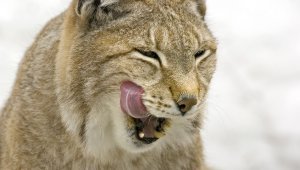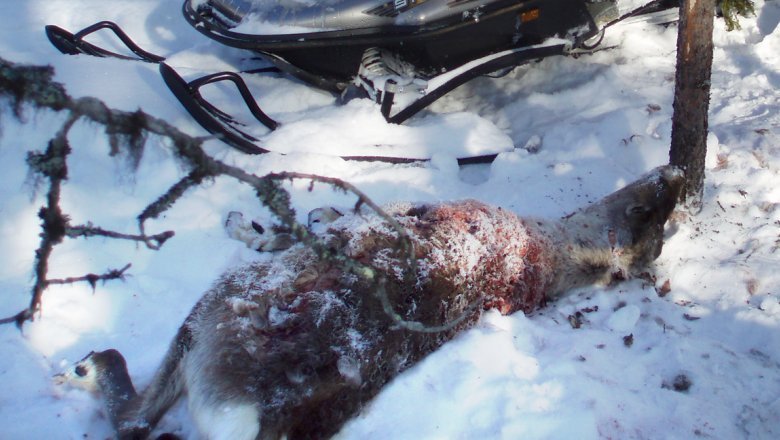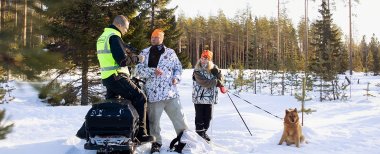Today, accumulated research data allows us to analyse the interactions between our large carnivores and the reindeer population in more detail. The short and long term variation in predator populations in the reindeer herding areas is, naturally, a significant factor. The amount of reindeer damage correlates strongly with the number of large carnivores in the area: the number of reindeer that fall prey to predators is higher in places with a dense predator population and lower where there are only few large carnivores. However, there are also other factors at play here, such as the species of the carnivores, their relationships with each other and the populations of alternative prey animals (e.g., moose, rabbit and grouse). Weather and other natural conditions and the health of the reindeer also affect their chances of falling prey to large carnivores.
Large carnivores in Finland's reindeer herding area
Finland's reindeer herding area consists of almost the entire northern part of the country. The most numerous large carnivore in the area is the brown bear. The summer is a significant time for reindeer herding as it is in the summer that herders find out how the new calves are doing. Bears cause reindeer damages especially in May during calving season and in early June. Calves are the bear's preferred target, but they can also kill adult reindeer. The bear also preys on reindeer in the autumn as it is getting ready to hibernate.
Out of our four large carnivore species, the wolverine is the most significant cause of reindeer damages when looking at the reindeer herding area as a whole. In 2013 the wolverine caused more reindeer damages than the other three species combined. Wolverines kill reindeer primarily in early spring and the target is usually a breeding female. The wolverine is a strictly protected species everywhere in Finland and no exceptional permits have been issued for wolverine hunting like there have been for the other large carnivores. The wolverine is especially prevalent in the fell areas of Enontekiö, Inari and Utsjoki, but it also likes the woodland areas near Finland's eastern border. Wolverines that live in the woods are called forest wolverines. Damages caused by the wolverine are practically unheard of outside of the reindeer herding area.
Finland's lynx population is no longer as heavily concentrated in the Rovaniemi area as it used to be and the lynx has spread to other parts of the country as well. Especially the south-eastern and eastern reindeer herding areas have seen a rise in the number of lynxes. Lynx damages have also been on the rise in recent years and lynxes now cause more reindeer damages than wolves. On the local level, reindeer damages caused by the lynx may be considerable.
Out of our large carnivores, the wolf is responsible for the highest number of reindeer damages in relation to the size of its population. The number of wolves that do not have formed territories that roam the reindeer herding area is influenced by the number of animals migrating from Russia and elsewhere in Finland, and this migration may vary widely depending on the season. The reindeer herding area has not served as an actual breeding ground for wolves in recent years and only a few wolf litters have been born there in the last decade. The minimum number of litters specified in Finland's wolf population management plan is 20, and this number is best reached elsewhere in Finland where there is enough space for a wolf population that size while ensuring that wolf damages remain reasonable.
Despite its small population, the wolf caused over 1.3 million euros worth of reindeer damages in 2012. However, this number dropped to 0.5 million euros in 2013. In 2013 the wolverine was the worst offender as it caused over 5 million euros worth of damages and the lynx's total that year came to nearly 1.3 million euros. The bear caused 0.8 million euros worth of damage to reindeer. 2014 seems to have seen a significant reduction in both wolverine and lynx damages.
Compensation for reindeer damages caused by large carnivores
The state of Finland compensates reindeer owners for reindeer damages caused by large carnivores (bear, wolverine, lynx and wolf) within the limits set by the state's budget. The Ministry of Agriculture and Forestry is responsible for paying the compensations. The compensation is paid directly to the reindeer owner in the event that the owner recognises the reindeer carcass by its earmark or other identifier, such as a collar. If the reindeer carcass cannot be identified, the compensation is paid to the reindeer herding district where the carcass was found.
Reindeer damages caused by the golden eagle are the responsibility of the Ministry of the Environment.


